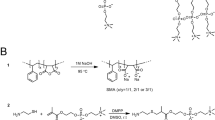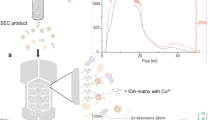Abstract
AFFINITY chromatography, which uses a specific ligand coupled to a solid matrix to adsorb selectively a macromolecule, has been used extensively in the purification of soluble proteins1. Although the purification of cells or cellular membrane fragments containing surface receptors has been attempted with this procedure2–15, the approach has been less successful because of difficulties in eluting bound particulate substances from the solid matrix. Recently, we described a method called affinity partitioning16 for separating soluble proteins in aqueous polymer two-phase systems17 by adding a polymfer-ligand with a relatively high affinity for a binding site on the protein to be purified, and a solubility preference for one of the phases. Since cells and cell fragments18,19 can be partitioned and recovered from aqueous polymer two-phase systems, it seemed possible that the principle of affinity partitioning could be used in their fractionation. With the absence of a solid matrix, problems of recovery would be obviated. We describe here the use of polymer coupled to a ligand that binds to the nicotinic cholinergic receptor site to purify cholinergic receptor enriched membranes derived from electroplax of Torpedo californica.
This is a preview of subscription content, access via your institution
Access options
Subscribe to this journal
Receive 51 print issues and online access
$199.00 per year
only $3.90 per issue
Buy this article
- Purchase on Springer Link
- Instant access to full article PDF
Prices may be subject to local taxes which are calculated during checkout
Similar content being viewed by others
References
Cuatrecasas, P., and Anfinsen, C. B., A. Rev. Biochem., 40, 259–278 (1971).
Wigzell, H., and Anderson, B., J. exp. Med., 129, 23–36 (1969).
Wigzell, H., and Mäkelä, O., J. exp. Med., 132, 110–126 (1970).
Wigzell, H., Transplant. Rev., 5, 76–104 (1970).
Evans, M. W., Mage, M. G., and Petersen, E. A., J. Immun., 102, 899–907 (1969); ibid. 102, 908–910 (1969).
Truffa-Bachi, P., and Wofsy, L., Proc. natn. Acad. Sci. U.S.A., 66, 685–692 (1970).
Wofsy, L., Kumura, J., and Truffa-Bachi, P., J. Immun., 107, 725–729 (1971).
Edelman, G. M., Rutishauer, U., and Millette, C. F., Proc. natn. Acad. Sci. U.S.A., 68, 2153–2157 (1971); ibid. 69, 1596–1600 (1972).
Rutishauer, U., d'Eustacio, P., and Edelman, G. M., Proc. natn. Acad. Sci. U.S.A., 70, 3894–3898 (1973).
Choi, T. K., Sleight, D. R., and Nisonoff, S., J. exp. Med., 139, 761–766 (1974).
Rutishauer, U., and Sachs, L., Proc. natn. Acad. Sci. U.S.A., 71, 2456–2460 (1974).
Soderman, D. D., Germeshauser, J., and Katzen, H. M., Proc. natn. Acad. Sci. U.S.A., 70, 792–796 (1973).
Melmon, K. L., Bourne, H. R., Weinstein, Y., and Sela, M., Science, 177, 707–709 (1972).
Weinstein, Y., Melmon, K. L., Bourne, H. R., and Sela, M., J. clin. Invest., 52, 1349–1361 (1973).
Zachowski, A., and Parof, A., Biochem. Res. Comm., 57, 787–792 (1974).
Flanagan, S. D., and Barondes, S. H., J. biol. Chem., 250, 1484–1489 (1975).
Albertsson, P. Å., Partition of cell particles and macromolecules, second ed. (Almqvist and Wiksell, Stockholm, 1971).
Walter, H., Methods in enzymology, 32 (Academic, New York, in the press).
Albertsson, P. Å., Methods in enzymology, 31, 761–769 (Academic, New York, 1974).
Nickel, E., and Potter, L. T., Brain Res., 57, 508–517 (1973).
Cartaud, J., Benedetti, L., Cohen, J. B., Meunier, J. C., and Changeux, J.-P., FEBS Let., 33, 109–113 (1973).
Weber, M., and Changeux, J.-P., Molec. Pharmacol., 10, 1–40 (1974).
Duguid, J. R., and Raftery, M. A., Biochemistry, 12, 3593–3597 (1973).
Johansson, G., Hartman, A., and Ålbertsson, P. A., Eur. J. Biochem., 33, 379–386 (1973).
Chang, H. W., Proc. natn. Acad. Sci. U.S.A., 71, 2113–2117 (1974).
Schmidt, J., and Raftery, M. A., Anal. Biochem., 52, 349–354 (1973).
Reitherman, R., Flanagan, S. D., and Barondes, S. H., Biochim. biophys. Acta, 29, 193–202 (1973).
Avruch, J., and Wallach, D. F. H., Biochim. biophys. Acta, 233, 334–347 (1971).
Reed, J., Goto, K., and Wang, C., Anal. Biochem., 16, 59–64 (1966).
Author information
Authors and Affiliations
Rights and permissions
About this article
Cite this article
FLANAGAN, S., TAYLOR, P. & BARONDES, S. Affinity partitioning of acetylcholine receptor enriched membranes and their purification. Nature 254, 441–443 (1975). https://doi.org/10.1038/254441a0
Received:
Issue Date:
DOI: https://doi.org/10.1038/254441a0
This article is cited by
-
Characterization and application of a new aqueous two phase system based on gum acacia (ex.Acacia senegal), a naturally occuring polysaccharide, and polyethylene glycol
Biotechnology Techniques (1989)
-
Hydrophobic surface properties of erythrocytes studied by affinity partition in aqueous two-phase systems
Molecular and Cellular Biochemistry (1976)
Comments
By submitting a comment you agree to abide by our Terms and Community Guidelines. If you find something abusive or that does not comply with our terms or guidelines please flag it as inappropriate.



